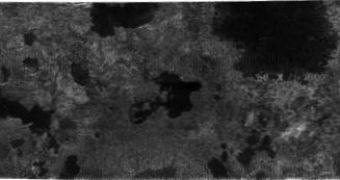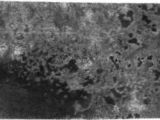The lakes are most likely the source of hydrocarbon smog in the frigid moon's atmosphere. Finding the source of the complex soup of hydrocarbons in Titan's atmosphere has been a major goal for the Cassini mission and is a significant accomplishment.
Numerous well-defined dark patches resembling lakes are present in radar images of Titan's high latitudes taken during a July 22 flyby. At Titan's frigid temperatures, about minus 180 degrees Celsius, the liquids in the lakes are most likely methane or a combination of methane and ethane.
Titan has not yielded its secrets easily because the dense smoggy atmosphere makes it very difficult to obtain good visible images. But radar can penetrate the smog and obtain clear images. Dark regions in radar images generally mean smoother terrain, while bright regions mean a rougher surface.
Scientists have speculated that liquid methane or ethane might form lakes on Titan, particularly near the somewhat colder Polar Regions. In the images, a variety of dark patches, some with channels leading in or out of them, appear. The channels have a shape that strongly implies they were carved by liquid. Some of the dark patches and connecting channels are completely black, that is, they reflect back essentially no radar signal, and hence must be extremely smooth. In some cases rims can be seen around the dark patches, suggesting deposits that might form as liquid evaporates.
"We've always believed Titan's methane had to be maintained by liquid lakes or extensive underground 'methanofers,' the methane equivalent of aquifers. We can't see methanofers but we can now say we've seen lakes," said Jonathan Lunine, Cassini interdisciplinary scientist at the University of Arizona, Tucson.
The abundant methane in Titan's atmosphere is stable as a liquid under Titan conditions, as is its abundant chemical product, ethane, but liquid water is not. For all these reasons, scientists interpret the dark areas as lakes of liquid methane or ethane, making Titan the only body in the solar system besides Earth known to possess lakes.
Because such lakes may wax and wane over time, and winds may alter the roughness of their surfaces. Repeat coverage of these areas should test whether indeed these are bodies of liquid. By passing over a lake in a different direction, Cassini may see the effect of prevailing winds in the changing brightness of the lake surface. Cassini's next flyby of Titan is on September 7. In October, Cassini's radar will look even closer to the North Pole, searching for more lakes and mapping more of the polar region covered by these features.
"This is a big deal," said Steve Wall, deputy radar team leader at NASA's Jet Propulsion Laboratory, Pasadena, Calif. "We've now seen a place other than Earth where lakes are present."
This area of Titan has been in winter's shadow since before Cassini arrived, and the spacecraft had not flown over it before. During the flyby, Cassini's radar spotted several dozen lakes as small as 0.6 miles wide, with some nearly 20 miles wide. The biggest lake is about 62 miles long and may be only partly wet.
"What we see is darker than anything we've ever seen elsewhere on Titan. It was almost as though someone laid a bull's-eye around the whole north pole of Titan, and Cassini sees these regions of lakes just like those we see on Earth," said Larry Soderblom, Cassini interdisciplinary scientist at the U.S. Geological Survey, Flagstaff, Ariz. "Titan has turned out to be like a musical crescendo -- each pass is more exciting than the last."

 14 DAY TRIAL //
14 DAY TRIAL // 
